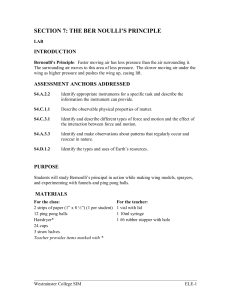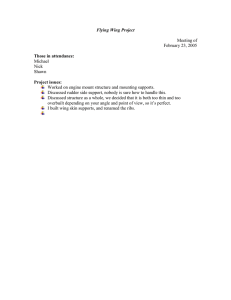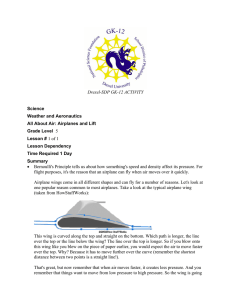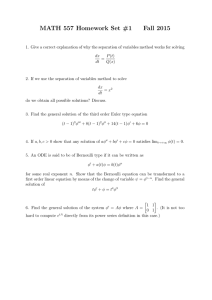Bernoulli`s Principle – "Physics for Scientists
advertisement
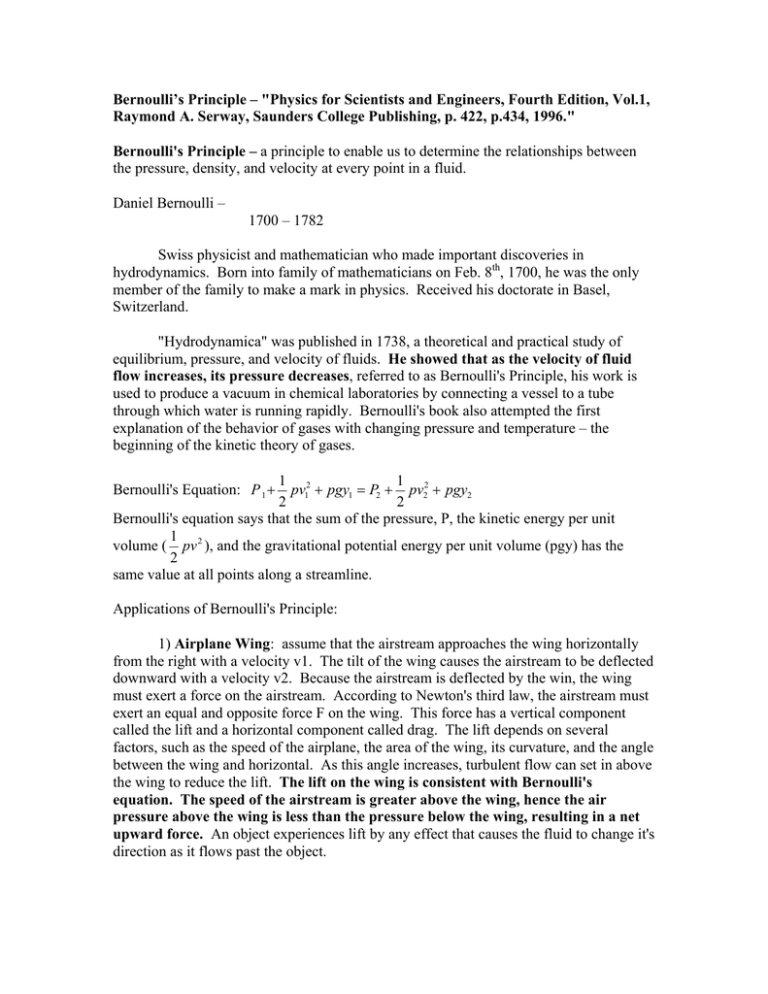
Bernoulli’s Principle – "Physics for Scientists and Engineers, Fourth Edition, Vol.1, Raymond A. Serway, Saunders College Publishing, p. 422, p.434, 1996." Bernoulli's Principle – a principle to enable us to determine the relationships between the pressure, density, and velocity at every point in a fluid. Daniel Bernoulli – 1700 – 1782 Swiss physicist and mathematician who made important discoveries in hydrodynamics. Born into family of mathematicians on Feb. 8th, 1700, he was the only member of the family to make a mark in physics. Received his doctorate in Basel, Switzerland. "Hydrodynamica" was published in 1738, a theoretical and practical study of equilibrium, pressure, and velocity of fluids. He showed that as the velocity of fluid flow increases, its pressure decreases, referred to as Bernoulli's Principle, his work is used to produce a vacuum in chemical laboratories by connecting a vessel to a tube through which water is running rapidly. Bernoulli's book also attempted the first explanation of the behavior of gases with changing pressure and temperature – the beginning of the kinetic theory of gases. 1 2 1 pv1 + pgy1 = P2 + pv22 + pgy2 2 2 Bernoulli's equation says that the sum of the pressure, P, the kinetic energy per unit 1 volume ( pv 2 ), and the gravitational potential energy per unit volume (pgy) has the 2 same value at all points along a streamline. Bernoulli's Equation: P 1 + Applications of Bernoulli's Principle: 1) Airplane Wing: assume that the airstream approaches the wing horizontally from the right with a velocity v1. The tilt of the wing causes the airstream to be deflected downward with a velocity v2. Because the airstream is deflected by the win, the wing must exert a force on the airstream. According to Newton's third law, the airstream must exert an equal and opposite force F on the wing. This force has a vertical component called the lift and a horizontal component called drag. The lift depends on several factors, such as the speed of the airplane, the area of the wing, its curvature, and the angle between the wing and horizontal. As this angle increases, turbulent flow can set in above the wing to reduce the lift. The lift on the wing is consistent with Bernoulli's equation. The speed of the airstream is greater above the wing, hence the air pressure above the wing is less than the pressure below the wing, resulting in a net upward force. An object experiences lift by any effect that causes the fluid to change it's direction as it flows past the object. Some factors that influence the lift are the shape of the object, its orientation with respect to the fluid flow, spinning motion (spinning baseball). And the texture of the object's surface. "http://library.thinkquest.org/11902/physics/curve2.html?tqskip1=1" 2) For a spinning ball, the stitches on the ball will cause pressure on one side to be less than on its opposite side. This will force the ball to move faster on one side than the other and will force the ball to "curve." This is the Magnus Effect. Nonspinning baseball Spinning baseball When a pitcher throws a curveball, he will throw it such that the axis of rotation is not perpendicular to the ground, as it is in a fastball. Because it is spinning in a skewed axis, the Magmus force will force the ball to curve in a horizontal direction instead of vertical "curve" of a fastball. 3) A stream of air passing over an open tube reduces the pressure above the tube. This reduction in pressure causes the liquid to rise into the airstream. The liquid is then dispersed into a fine spray of droplets. This atomizer is used in perfume bottles and paint sprayers. The same principle is used in the carburetor of a gasoline engine. In this case, the low-pressure region in the carburetor is produced by air drawn in by the piston through the air filter. The gasoline vaporizes, mixes with the air, and enters the cylinder of the engine for combustion. 4) Vascular flutter in a person with advanced arteriosclerosis: The artery is constricted as a result of an accumulation of plaque on its inner walls. In order to maintain a constant flow rate through such a constricted artery, the driving pressure must increase. Such an increase in pressure requires a greater demand on the heart muscle. If the blood speed is sufficiently high in the constricted region, the artery may collapse under external pressure, causing a momentary interruption in blood flow. At this point, Bernoulli's equation does not apply, and the vessel reopens under arterial pressure. As the blood rushes through the constricted artery, the internal pressure drops and again the artery closes. Such variations in blood flow can be heard with a stethoscope. If the plaque becomes dislodged and ends up in a smaller vessel that delivers blood to the heart, the person can suffer a heart attack.
